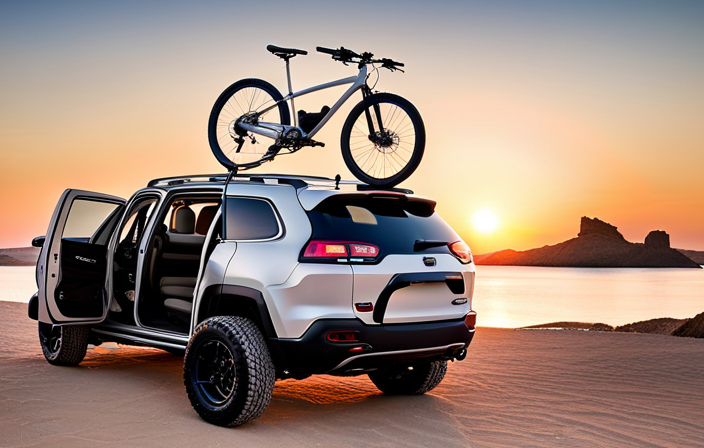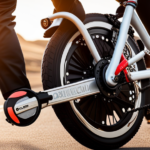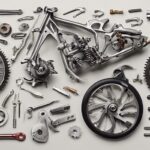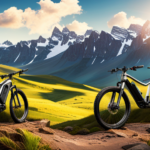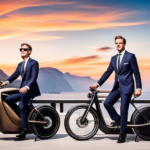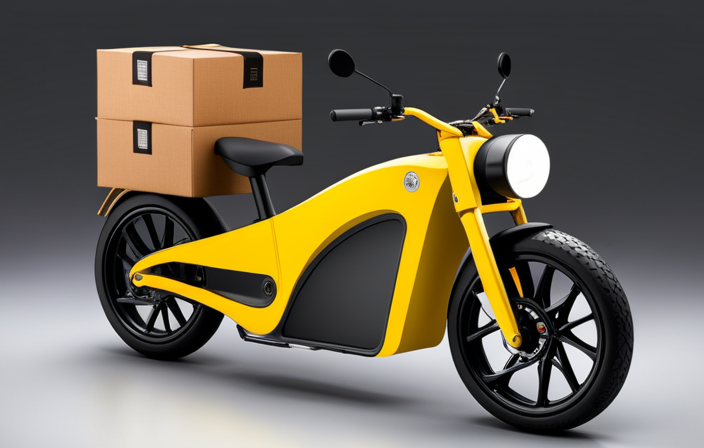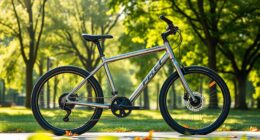As an avid electric bike enthusiast, I often find myself pondering the question, ‘Which motor is best for my electric bike?’ With so many options available, it can be overwhelming to determine the perfect fit.
In this article, I will guide you through the various types of electric bike motors, considering factors such as power, efficiency, compatibility, and placement. We will also explore cost, maintenance, performance, and additional features.
Join me on this journey to find the ideal motor for your electric bike.
Key Takeaways
- Hub motors located in the center or rear wheel are a popular choice for electric bikes.
- Mid-drive motors integrated into the bike’s frame offer better weight distribution and handling.
- Battery capacity determines the energy storage of the electric bike.
- Proper gear ratios and energy-efficient motors maximize the efficiency and battery life of the electric bike.
Types of Electric Bike Motors
When it comes to electric bike motors, you’ll want to consider the different types available. One of the most common types is the hub motor, which is located in the center or rear wheel of the bike. These motors provide a smooth and quiet ride, and their power output can range from 250 watts to over 1000 watts.
Another type is the mid-drive motor, which is integrated into the bike’s frame and drives the crankshaft directly. These motors offer better weight distribution and a more natural riding experience. They also tend to have higher power output, making them suitable for hilly terrains.
Transitioning into the next section, power and efficiency considerations are crucial when choosing the right motor for your electric bike.
Power and Efficiency Considerations
To maximize power and efficiency, you’ll want to consider factors like battery capacity, motor size, and gear ratios. Motor power directly affects the performance of an electric bike, while battery efficiency determines how long it can sustain that power. When choosing a motor, it’s important to balance power and efficiency to ensure optimal performance. Here are some key considerations:
| Factors | Description |
|---|---|
| Battery Capacity | Determines the amount of energy the battery can store. Higher capacity allows for longer rides. |
| Motor Size | Larger motors generally provide more power, but may also consume more energy. |
| Gear Ratios | Proper gear ratios allow the motor to operate at its most efficient speed, maximizing power and battery life. |
Compatibility with Electric Bike Models
Make sure you evaluate the compatibility of different motors with your preferred electric bike models. Motor compatibility is crucial in ensuring optimal performance and efficiency of your electric bike. Here are a few key factors to consider:
-
Power output: Choose a motor that matches the power requirements of your intended use. Whether you need a motor for commuting or off-road adventures, selecting the right power output will enhance your riding experience.
-
Torque: A motor with high torque will provide better acceleration and climbing capabilities. Consider your riding style and terrain to determine the appropriate torque level.
-
Battery life: Opt for a motor that is energy-efficient to maximize your battery life. This will allow you to ride longer distances without worrying about running out of power.
By carefully evaluating these factors, you can ensure that your chosen motor is compatible with your electric bike model, providing you with a smooth and enjoyable riding experience.
Now, let’s explore the various motor placement options available for electric bikes.
Motor Placement Options
One option for motor placement on an e-bike is in the rear wheel hub. This mounting option provides a sleek and stealthy look, as the motor is integrated into the wheel itself. It offers several advantages, including easy installation and maintenance, as well as a balanced weight distribution. However, it is important to consider the impact on bike handling. Placing the motor in the rear wheel hub can affect the bike’s center of gravity, potentially making it feel heavier and reducing maneuverability. To give you a better understanding, here is a table outlining the different motor placement options and their impact on bike handling:
| Motor Placement | Impact on Bike Handling |
|---|---|
| Rear Wheel Hub | Potential weight increase and reduced maneuverability |
| Mid Drive | Better weight distribution and improved handling |
| Front Wheel Hub | Potential imbalance and reduced traction |
Considering the motor mounting options is crucial to ensure optimal performance and ride quality. Now, let’s delve into the next aspect to consider: cost and budget considerations.
Cost and Budget Considerations
When considering the cost and budget for an electric bike, it is important to understand the different options available for motors.
There are three main categories to consider: entry-level motors, mid-range motors, and high-end motors.
Entry-level motors are typically the most affordable option, providing basic functionality and performance.
Mid-range motors offer a balance between cost and performance, while high-end motors provide top-of-the-line features and superior performance, but at a higher price point.
Entry-Level Motors
The best entry-level motors for electric bikes are often more affordable and beginner-friendly. When it comes to motor power, entry-level motors typically range from 250 to 500 watts. While they may not provide the same level of speed and torque as higher-end motors, they are still capable of providing a decent amount of assistance for casual riders.
In terms of motor lifespan, entry-level motors generally have a lifespan of around 2,000 to 3,000 miles. This means that with regular maintenance and care, they can last several years before needing to be replaced.
Transitioning into the subsequent section about mid-range motors, it’s important to note that these motors offer a significant step up in terms of power and durability.
Mid-Range Motors
Mid-range motors, with their increased power and durability, are a popular choice for riders looking for a step up from entry-level options. These motors strike a balance between performance and affordability, making them a great choice for riders who want a boost in motor power without breaking the bank.
Here are some key features of mid-range motors:
-
Motor Efficiency: Mid-range motors are designed to maximize efficiency, ensuring that energy is used effectively and minimizing power loss. This means riders can go further on a single charge, making these motors ideal for longer rides or commutes.
-
Motor Power: Mid-range motors typically offer more power than entry-level options, allowing riders to tackle steeper inclines and rough terrain with ease. The increased power also improves acceleration, giving riders a more exhilarating riding experience.
-
Durability: Mid-range motors are built to withstand the demands of regular use, making them a reliable choice for everyday riders. Whether you’re commuting to work or exploring off-road trails, a mid-range motor will provide the strength and longevity you need.
Transitioning into the next section about high-end motors, it’s clear that riders who have experienced the benefits of mid-range motors may be ready for even more advanced features and performance.
High-End Motors
Transitioning into high-end motors, riders can expect even more advanced features and performance. High-performance motors are designed to provide maximum power and efficiency, making them ideal for experienced riders or those who demand top-of-the-line performance.
Advanced motor technology allows for improved torque and acceleration, enabling riders to tackle steep hills and rough terrain with ease. These motors often incorporate features such as regenerative braking, which helps extend battery life, and customizable power settings that allow riders to fine-tune their riding experience.
Additionally, high-end motors are typically lighter and more compact, providing a sleek and streamlined look to the electric bike. With their superior performance and cutting-edge technology, high-end motors offer an exhilarating ride for those seeking the ultimate electric biking experience.
Moving on to noise and vibration levels…
Noise and Vibration Levels
Noise and vibration levels can greatly impact the overall riding experience of an electric bike. When it comes to electric bike motors, it is important to consider vibration reduction techniques in order to enhance rider comfort and experience. Here are three key factors to consider:
-
Motor Mounting: The way the motor is mounted on the bike frame plays a crucial role in reducing vibrations. Proper mounting techniques, such as using rubber isolators or dampeners, can help absorb vibrations and minimize their transfer to the rider.
-
Motor Design: Some manufacturers incorporate advanced engineering techniques to reduce vibrations in their motor design. This can include the use of precision-balanced components or the integration of vibration-damping materials to minimize noise and vibrations.
-
Controller Tuning: The controller is responsible for regulating the power output of the motor. Proper tuning of the controller can help reduce vibration levels by ensuring smooth and efficient power delivery.
Reducing noise and vibrations not only enhances rider comfort, but it also improves the overall riding experience. It allows riders to enjoy a smoother and more enjoyable electric bike journey.
When it comes to maintenance and durability, there are several key factors to consider.
Maintenance and Durability
When it comes to the maintenance and durability of electric bike motors, there are a few key points to consider.
First, the motor lifespan is an important factor to determine how long the motor will last before needing replacement or repairs.
Waterproof and dustproof ratings are also crucial as they ensure the motor can withstand various weather conditions and environments without getting damaged.
Lastly, easy maintenance features such as accessible parts and simple cleaning methods can greatly contribute to the overall durability and longevity of the motor.
Motor Lifespan
If you take care of it properly, your electric bike’s motor can last for several years. Motor reliability is an important aspect to consider when purchasing an electric bike. To ensure the longevity of your motor, it is essential to follow proper maintenance and servicing guidelines. Additionally, it is advisable to check the motor warranty provided by the manufacturer. A good motor warranty can give you peace of mind and protect your investment. To help you make an informed decision, here is a table summarizing the motor reliability and warranty of some popular electric bike brands:
| Brand | Motor Reliability | Motor Warranty |
|---|---|---|
| Brand A | Excellent | 2 years |
| Brand B | Good | 1 year |
| Brand C | Very Good | 3 years |
| Brand D | Average | 6 months |
Considering the motor lifespan and warranty is crucial when choosing the best electric bike for your needs. Now, let’s delve into another important aspect – the waterproof and dustproof ratings of electric bike components.
Waterproof and Dustproof Ratings
To ensure the longevity of your investment, make sure to consider the waterproof and dustproof ratings of the components on your electric bike. Water resistance and dust protection are crucial factors to consider when choosing the right electric bike.
The electrical components, such as the motor and battery, should have high IP (Ingress Protection) ratings to ensure they are adequately protected from water and dust. Look for components with a minimum IPX4 rating, which means they are resistant to water splashes from any direction. This will protect your electric bike from damage caused by rain or puddles. Additionally, a high IP rating will ensure that dust particles don’t penetrate the components, preventing any potential issues.
By choosing electric bike components with excellent water resistance and dust protection, you can ride worry-free in various weather conditions and maintain optimal performance.
Speaking of maintenance, let’s now explore the easy maintenance features of electric bikes.
Easy Maintenance Features
Take advantage of the easy maintenance features available on your electric bike, such as quick-release wheels and a removable battery, to simplify upkeep and keep your bike in optimal condition. These features make it easier to perform regular maintenance tasks and troubleshoot any issues that may arise. Here are some maintenance tips and a troubleshooting guide to help you keep your electric bike running smoothly:
| Maintenance Tips | Troubleshooting Guide |
|---|---|
| Regularly clean your bike | Check battery connections |
| Check tire pressure | Inspect motor and wiring |
| Lubricate chain and gears | Test brakes |
Performance and Speed
When it comes to electric bike performance, two key factors to consider are acceleration and torque.
Acceleration refers to how quickly the bike can go from a standstill to a certain speed, while torque measures the bike’s ability to maintain speed and handle inclines.
Additionally, maximum speed is another important aspect to take into account, as it determines the top speed the bike can reach.
Understanding these factors will allow you to choose an electric bike that meets your desired level of performance and speed.
Acceleration and Torque
You’ll want to choose a motor with high acceleration and torque for maximum power on your electric bike. When it comes to motor efficiency, a higher efficiency rating means the motor can convert more electrical energy into mechanical energy, resulting in better overall performance. Additionally, power output is another crucial factor to consider. A motor with a higher power output will provide more energy to propel your bike forward, giving you better acceleration and climbing abilities.
To ensure you get the most out of your electric bike, here are some key factors to keep in mind when selecting a motor:
-
Motor efficiency:
-
Look for motors with higher efficiency ratings to maximize the energy conversion process.
-
Efficient motors will provide better range and longer battery life.
-
Power output:
-
Choose a motor with a higher power output for increased acceleration and better performance on steep terrains.
-
Higher power output motors can handle heavier loads and offer a smoother riding experience.
Considering these factors will help you select a motor that optimizes acceleration and torque, ensuring maximum power for your electric bike.
Now, let’s delve into the next section and explore the importance of maximum speed.
Maximum Speed
Now that we’ve covered acceleration and torque, let’s talk about how to maximize your electric bike’s maximum speed.
To achieve the highest speed possible, it’s important to consider both the acceleration capabilities and the battery range of your electric bike. A powerful motor with high torque will allow for quick acceleration, getting you up to top speed faster.
Additionally, a larger battery capacity will provide a longer range, allowing you to maintain that maximum speed for a longer period of time. By choosing a motor with strong acceleration capabilities and a battery with a sufficient range, you can ensure that your electric bike will be able to reach and sustain its highest speed potential.
Now, let’s delve into the exciting world of additional features and accessories that can enhance your electric biking experience.
Additional Features and Accessories
As you’re considering which motor to choose for your electric bike, don’t forget to think about the additional features and accessories that can enhance your riding experience.
When it comes to accessories for electric bikes, there are a variety of options available that can make your rides more enjoyable and convenient. Here are a few benefits of adding these features to your electric bike:
-
LED lights: Illuminate your path and increase visibility, ensuring a safe ride even in low-light conditions.
-
Rear rack: Carry your belongings with ease, whether it’s groceries, a backpack, or even a picnic basket for a leisurely ride.
-
Fenders: Keep yourself clean and dry by protecting your clothes from splashes and mud.
By incorporating these accessories, you can customize your electric bike to suit your needs and preferences.
Now, let’s dive into customer reviews and recommendations to help you make an informed decision.
Customer Reviews and Recommendations
By reading customer reviews and recommendations, you can gain valuable insights into the performance and satisfaction of different electric bike models.
It is important to consider customer satisfaction when choosing an electric bike, as it reflects how well the bike meets the needs and expectations of its users. A high level of customer satisfaction indicates that the bike is reliable and provides a positive riding experience.
Additionally, customer reviews can also provide information about the longevity of the bike, giving you an idea of how well it holds up over time. Look for bikes that have consistently positive reviews and high ratings for both reliability and longevity.
This will ensure that you are investing in an electric bike that will provide you with years of enjoyable and hassle-free riding.
Frequently Asked Questions
Can I use any motor on any electric bike model?
No, not all motors are compatible with every electric bike model. It’s important to consider the specific motor compatibility for your bike. Different motors have different performance characteristics, so choose one that suits your needs.
What are the noise and vibration levels typically associated with electric bike motors?
Curious about electric bike motor noise and vibration levels? Well, let me tell you: electric bike motors generally have low noise levels and minimal vibrations, making for a smoother and more enjoyable riding experience.
Are there any additional features or accessories that can be added to electric bike motors?
There are various additional features and accessories that can be added to electric bike motors. These include different types of batteries for electric bike motors and tips on how to choose the right size motor for an electric bike.
How do maintenance and durability differ between different types of electric bike motors?
Maintaining and ensuring durability of electric bike motors depends on the type. When comparing different motors, it’s essential to consider their maintenance requirements and durability advantages. Regular care and proper upkeep contribute to their longevity.
Can you provide some customer reviews and recommendations for specific electric bike motors?
Based on customer reviews, I recommend the Bafang BBS02B and the Bosch Performance Line CX motors. The Bafang is praised for its power and affordability, while the Bosch offers excellent performance and durability.
Conclusion
After careful consideration and research, it is clear that choosing the best motor for an electric bike depends on various factors. These factors include power, efficiency, compatibility, placement, cost, maintenance, performance, and additional features. Each individual’s needs and preferences will ultimately determine which motor is the best fit for their electric bike.
So, which motor will you choose to enhance your electric biking experience? Will you prioritize power and speed or focus on efficiency and durability? The choice is yours to make.
